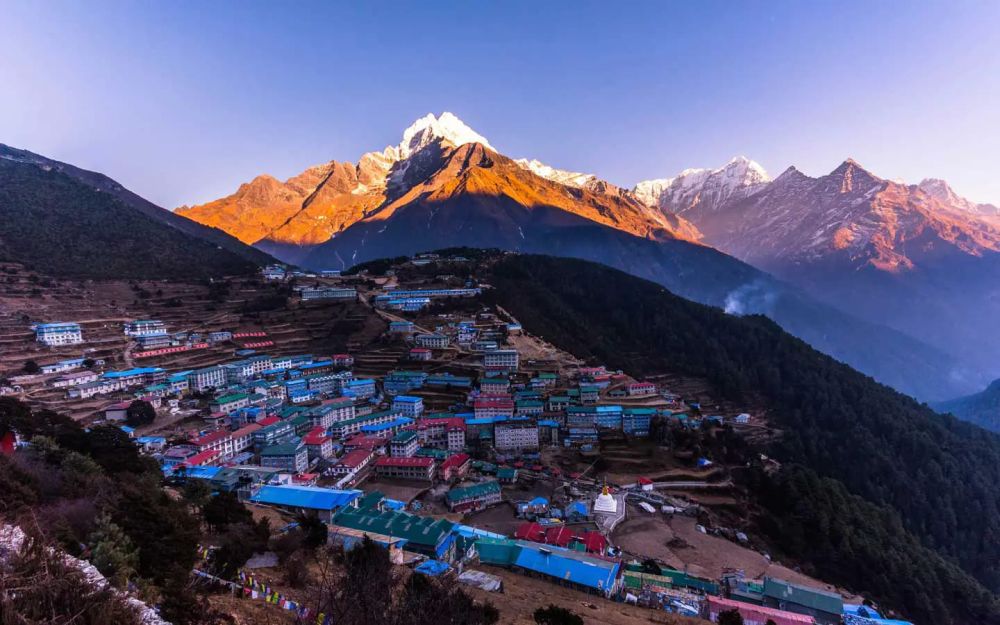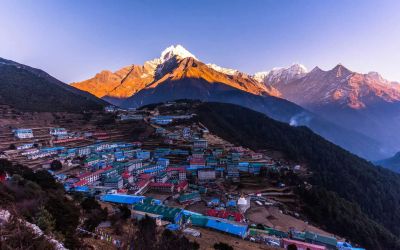

The Everest View Trek is an exhilarating journey that immerses trekkers in the heart of the Sherpa homeland, offering stunning views of the world's highest peaks. Starting from Namche Bazar, it's a shorter alternative to the full Everest Base Camp trek, tailored for those with limited time or who are looking for a less challenging experience. During this trek, participants will navigate through lush rhododendron forests, quaint Sherpa villages, and Buddhist monasteries, all while being surrounded by the breathtaking Himalayan landscape. The highlight for many is reaching the famed viewpoint at Syangboche Airport, where the panoramic views of Mount Everest, Lhotse, Ama Dablam, and other towering mountains are truly unforgettable. The experience also offers a rich cultural exposure, with opportunities to learn about Sherpa culture and traditions.
Amidst the journey to Everest Base Camp, trekkers often spend an acclimatization day in Namche Bazaar to adjust to the higher altitude. An ideal way to maximize this day is by embarking on an acclimatization hike, which may include ventures to the Everest View Hotel or the Khumjung village. Participants will get to experience the local Sherpa culture, visit a school established by Sir Edmund Hillary, and if time permits, see the famed Yeti skull at the Khumjung Monastery. This day hike helps trekkers adjust to the altitude while enjoying magnificent views of peaks like Ama Dablam and Thamserku, and the imposing Kongde Ri.
The Sherpa Culture Museum in Namche Bazaar is a window to the customs, traditions, and history of the Sherpa people who are indigenous to the Everest region. This museum showcases a collection of artifacts, traditional Sherpa household items, clothing, and mountaineering exhibits, shedding light on the Sherpa way of life and their integral role in Himalayan expeditions. The museum's location allows visitors to revel in the captivating architecture that reflects Sherpa heritage and also to enjoy the beautiful surroundings of Namche Bazaar. A visit to the museum is both educational and inspirational and is often combined with a stop at the neighboring Sagarmatha National Park Visitor Center.
Every week, the heart of Namche Bazaar comes alive with the vibrant Saturday Market, also known as 'Haat Bazaar'. This traditional market is a bustling hub where local traders from surrounding villages and as far as Tibet come together to sell a variety of goods. Here, trekkers and locals alike can browse and shop for items such as fresh produce, traditional clothing, yak cheese, and handicrafts. It's an excellent opportunity for visitors to immerse themselves in the local culture, practice their bartering skills, and pick up unique souvenirs or supplies for their trek. The market's colorful atmosphere and the blend of diverse cultures make for a memorable experience.
Nestled within the green hills of Namche Bazaar is the Tenzing Norgay Memorial Stupa, built in honor of the legendary Sherpa Tenzing Norgay who, together with Sir Edmund Hillary, became one of the first individuals to reach the summit of Mount Everest in 1953. This historical monument is a place of tranquility and respect, with prayer flags fluttering in the wind, providing a scenic spot for reflection and meditation. Visitors are often captivated by the sweeping views of the surrounding Himalayas from this location. An integral part of any visit to Namche, the stupa also serves as a gentle reminder of the courage and determination that defines the spirit of mountaineering.
With Namche Bazaar being the gateway to the higher regions of the Khumbu valley, a hike within the Sagarmatha National Park is a must-do for nature enthusiasts. The park, a UNESCO World Heritage Site, encompasses a variety of landscapes, from dense forests and alpine shrublands to rugged terrain with glacial rivers. A hike through the park offers a chance to encounter an array of biodiversity including rare species like the snow leopard and Himalayan tahr. Interpretive signs along the trails provide insightful information about the park's delicate ecosystem. Beyond the natural wonders, hikers can also visit the local monasteries and catch glimpses of the towering peaks, including Everest itself.
A gentle walk from Namche Bazaar leads to the charming twin villages of Khunde and Khumjung. Set against the dramatic backdrop of sacred Khumbila Mountain, these villages offer insights into the peaceful rural lifestyle of the Sherpa people. Touring these villages allows visitors to interact with the friendly locals, visit the Khumjung Gompa where the purported Yeti scalp is kept, and possibly volunteer at the local clinic or school. With its serene atmosphere and less-traveled paths, the tour provides a welcome respite from the busier trails and showcases the harmonious balance between traditional Sherpa culture and the influences of modernity.
For those short on time or unable to trek for days, a helicopter tour from Namche Bazaar to Everest Base Camp offers an unforgettable aerial perspective of the Himalayas. This tour provides majestic views of the world's highest peaks, glaciers, and pristine alpine scenery. Passengers will experience thrilling landings at vantage points with unrivaled panoramic vistas, and the flight often includes a stop for breakfast with a view at the Everest View Hotel. It's a luxurious and awe-inspiring way to witness the grandeur of Everest without the physical demands of trekking.
Namche Bazaar, surrounded by the serene beauty of the Himalayas, is a perfect place for a spiritual retreat. Local lodges and retreat centers offer yoga and meditation programs for visitors looking to relax and find inner peace in the midst of nature. Under the guidance of experienced instructors, participants will engage in daily yoga practices, mindfulness meditation sessions, and breathing exercises, all designed to enhance physical and mental well-being. These retreats often include healthy, locally-sourced meals, and provide a unique opportunity to connect with oneself in the tranquil high-altitude environment.
Given Namche Bazaar’s rugged and mountainous terrain, it's an ideal setting for rock climbing enthusiasts. Several outfitters in the area offer guided climbs on nearby established routes ranging from beginner to advanced levels. Climbers are equipped with necessary gear and accompanied by experienced guides to ensure safety while tackling the natural rock faces of the Khumbu region. This adrenaline-pumping activity not only tests one's climbing skills but also provides an alternative way to appreciate the area's striking landscapes. Plus, it's a fun physical challenge off the typical trekking path.
